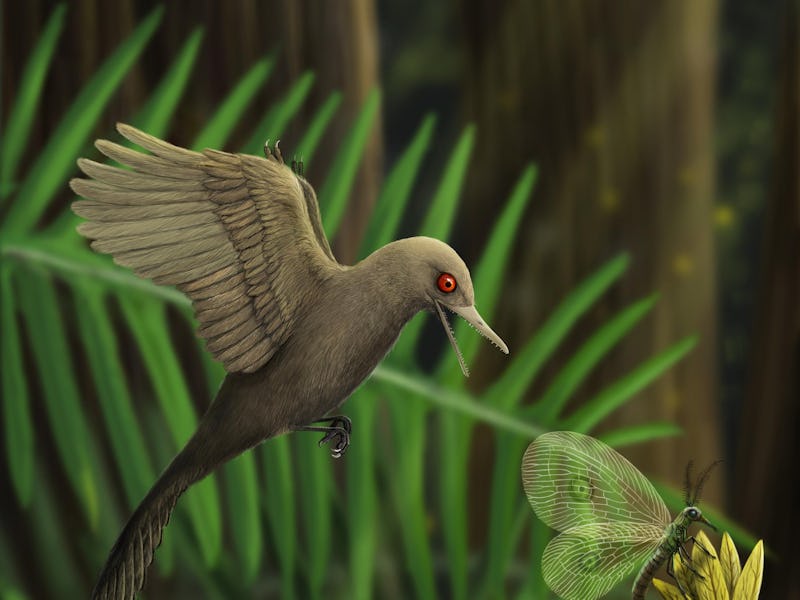Perfectly preserved teeny dino looks like a nightmare hummingbird
Though it may be small, it is fierce.

Not all dinosaurs were massive, terrifying creatures. They could be teeny, terrifying creatures, too.
Meet Oculudentavis khaungraae, aka the "nightmare hummingbird."
A new study published Wednesday in the journal Nature describes the newly minted Oculudentavis khaungraae, a bird-like dinosaur discovered beautifully preserved in 99 million-year-old amber.
The dinosaur, found in northern Myanmar, is simply teeny. It measures just over 7 millimeters in length — about the size of the smallest bird alive today, the bee hummingbird. In fact, it may be the smallest dinosaur known to science, the researchers say.
“When I first saw the specimen, I was completely blown away,” Jingmai O’Connor, study author and a researcher at the Institute of Vertebrate Paleontology and Paleoanthropology in Beijing, China, said in a video accompanying the research.
“We’ve never seen anything like it,” she said.
CT scan of the minuscule dinosaur's skull.
The teeny dino dates to the Cretaceus period, which lasted from 145 to 66 million years ago.
The dinosaur's name means “eye tooth bird,” and a look at its skull reveals why: Large eye sockets dominate the skull, while its jaws likely held some 60 or so teeth — 30 on the top and the bottom — and most of them extremely sharp. The skull is also fused — a hallmark of dinosaur predators.
"Despite its teeny-tiny size, it was a predator,” O’Connor said.
Together, the three features reveal clues to how this terrifying, titchy creature lived: The eye sockets have a narrow opening that would have let in only a small amount of light, suggesting this dinosaur was active during the day. And the sharp teeth and fused skull likely mean it was a hunter, likely hunting down small arthropods or invertebrates.
“There’s nothing like this alive today,” she said. “So when we try to figure out what these morphologies mean, we really have to use a little bit of our imagination.”
“Oculudentavis khaungraae was just weird.”
Amber: A gateway to the past
The discovery would have been impossible were it not for the medium — amber.
“Paleontology right now is being completely transformed by the discovery of skeletal fossils, fossil vertebrates, preserved in amber,” O’Connor said. “When you have an animal preserved in amber, it looks like it just died yesterday.”
A tiny, newly discovered dinosaur skull, preserved in amber.
In amber fossils, all the soft tissue remains intact and in place, forming a “window into an ancient time,” O’Connor said.
“If it wasn't for amber, we wouldn’t know about this minute fauna at all," she said. “It's just incredible to uncover this new ecological niche that we never ever knew existed.”
Still, science is only just starting to learn from amber-preserved samples, O’Connor says. So far, investigations of fossils of this kind have been limited to researchers looking at what’s visible in the material, and doing some CT scans.
Future technology may one day allow researchers to get samples of ancient biochemistry, too — like analyzing feathers to determine their color — but that could be years down the road, she said.
“There’s a lot more cool stuff out there,” O’Connor said.
Editor's note: On July 22 the authors of this study issued a retraction note. They write: "Although the description of Oculudentavis khaungraae remains accurate, a new unpublished specimen casts doubts upon our hypothesis regarding the phylogenetic position of HPG-15-3."
Abstract: Skeletal inclusions in approximately 99-million-year-old amber from northern Myanmar provide unprecedented insights into the soft tissue and skeletal anatomy of minute fauna, which are not typically preserved in other depositional environments. Among a diversity of vertebrates, seven specimens that preserve the skeletal remains of enantiornithine birds have previously been described, all of which (including at least one seemingly mature specimen) are smaller than specimens recovered from lithic materials. Here we describe an exceptionally well-preserved and diminutive bird-like skull that documents a new species, which we name Oculudentavis khaungraae gen. et sp. nov. The find appears to represent the smallest known dinosaur of the Mesozoic era, rivalling the bee hummingbird (Mellisuga helenae)—the smallest living bird—in size. The O. khaungraae specimen preserves features that hint at miniaturization constraints, including a unique pattern of cranial fusion and an autapomorphic ocular morphology that resembles the eyes of lizards. The conically arranged scleral ossicles define a small pupil, indicative of diurnal activity. Miniaturization most commonly arises in isolated environments, and the diminutive size of Oculudentavis is therefore consistent with previous suggestions that this amber formed on an island within the Trans-Tethyan arc. The size and morphology of this species suggest a previously unknown bauplan, and a previously undetected ecology. This discovery highlights the potential of amber deposits to reveal the lowest limits of vertebrate body size.
This article was originally published on